Supermarine Seafire
Mks.III, XV & XVII
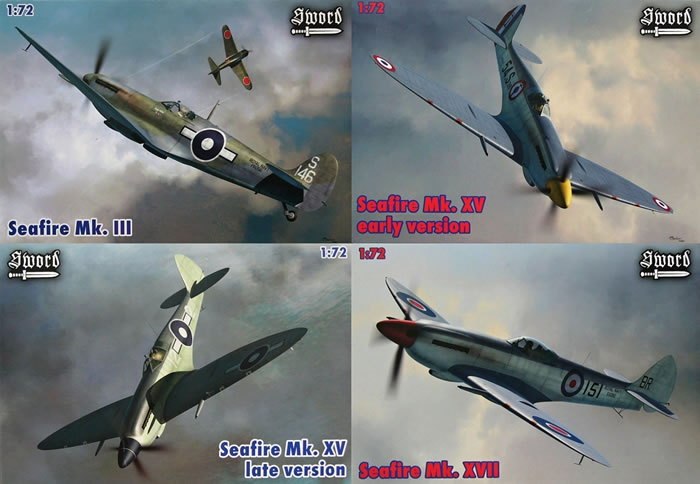
Sword, 1/72 scale
S u m m a r y : |
Catalogue Number: |
SW72055 Supermarine Seafire Mk.III
SW72056 Supermarine Seafire Mk.XV Early Version
SW72057 Supermarine Seafire Mk.XV Late Version
SW72058 Supermarine Seafire Mk.XVII |
Scale: |
1/72 |
Contents & Media: |
Seafire Version |
Grey Styrene Parts |
Clear Styrene Parts |
Resin Parts |
Decal Options |
Mk.III |
68 |
3 |
2 |
4 |
Mk.XV (Early) |
65 |
3 |
4 |
3 |
Mk.XV (Late) |
61 |
3 |
4 |
3 |
Mk.XVII |
62 |
3 |
4 |
3 |
Price: |
Available from these on-line stockists: |
Stockist |
Mk.III |
Mk.XV
Early Version |
Mk.XV
Late Version |
Mk.XVII |
Hannants |
£12.49 |
£12.49 |
£12.49 |
£12.49 |
Modelimex |
€14.58 |
€14.58 |
€14.58 |
€12.80 |
Click here for currency conversion. |
Review Type: |
First Look. |
Advantages: |
Accurate lines, fine surface detail, good cockpit detail, clear canopy, clean and crisp moulding for a limited run tool. |
Disadvantages: |
None observed. |
Conclusions: |
I consider these the best injected kits of the Seafire marks concerned in 1/72-scale. I believe they are equal in terms of accuracy and detail to the CMR’s resin Seafire kits that I used as benchmarks for this review, and over which they offer a significant price advantage due to their method of production. I highly recommend all four. |
|
|
|
|
|
|
|
|
|
|
Reviewed by
Mark Davies

Sword's 1/72 scale Seafires are available online from
Squadron.com
The Admiralty first floated the idea of a “Sea Spitfire” in mid-1938, and raised the matter again in late 1939, but RAF priorities were such that the request remained unfulfilled. It was not until late in 1941 that the first hooked Spitfire undertook carrier trials and these continued into early 1942.
The first navalised Spitfires, now called Seafires, were conversions of in-service Spitfire Vb’s. They had an A-frame arrester hook fitted with localised strengthening to absorb the extra loads imparted by shipboard landings, incorporated slinging points in the fuselage sides, and naval avionics replaced the RAF equipment. Deliveries of this first version, known as the Seafire Mk.Ib and powered by either Merlin 45 or 46 engines, commenced in mid-1942. From the 49th conversion onwards, Mk.Ib’s incorporated the same fuselage strengthening as used by the Mk.IIc described below. This no doubt stemmed from the development and conversion or production of the two marks being more or less concurrent, and the fact that failures of arrester hooks on some early Mk.Ib’s showed that greater strength was required than first thought.
Based on the Spitfire Mk.Vc, the Seafire Mk.IIc was the first production-line version rather than a conversion of in-service aircraft. Those produced by Supermarine’s factory initially utilised unfinished Spitfire Mk.Vc’s already on the assembly line, whereas all of those built by Westland started assembly as Seafires from the outset.
The Seafire Mk.IIc incorporated several changes from the first Mk.Ib’s. It had significant external strengthening added around the arrester hook mounting points, reinforcement around the radio hatch, external fishplates added to the mid-fuselage longerons, launch spools under the wings and various internal strengthening of the structure. Forty thousand man-hours were devoted to these design changes, but even so, there was an unavoidable growth in weight. This required a beefing up of the undercarriage legs that also had their forward raked increased by 2” to reduce the risk of nosing over. The Mk.IIc retained the Merlin 45, 46 engines of the Mk.Ib, but introduced the more powerful Merlin 32 engine for low-level fighter and reconnaissance use in conjunction with clipped wings. The Mk.IIc also adopted a four-blade propeller regardless of the engine version used.
Despite a preference for four cannon made possible by the C-wing, the Admiralty accepted that the weight penalty was too much for an aircraft already heavier than the Spitfire Vc. Therefore, the Seafire Mk.IIc had the same firepower as the Mk.Ib, although it could also carry a single 250-lb bomb on its centreline. The first production Seafire Mk.IIc flew in late-May 1942, yet Westland production did not get into its stride until late 1942.
The Seafire Mk.III was the first variant to have folding wings (Westland also produced 30 Hybrid Mk.III’s without folding wings at the end of Mk.IIc production). Folding wings were a huge benefit for stowage aboard ship as they reduced the span by 23’ 4”. The downside was that having folds also reduced the torsional stiffness of the wing by 10% and added 125-lbs of weight. The Mk.III was otherwise generally similar in appearance to the Mk.IIc. It used either the Merlin 55 or 55M engines that were similar to the Merlin 45/46 but offered barometrically controlled boost to reduce pilot workload. The more powerful Merlin 32 continued to for used the low-level fighter and reconnaissance roles. The Mk.III also introduced the ability to use centreline fuel tanks and could carry a single centreline 500-lb bomb, or alternately two 250-lb bombs or six 60-lb rocket projectiles under its wings.
The Seafire Mk.III served until a short time after the end of WW2, as well as serving post-war with the French Aeronavale and the Irish Air Corps. Griffon-engined Seafires had already begun to replace the Mk.III within the FAA just before the war’s end, and would do so later with the Aeronavale as well.
The Admiralty tested three modified “hooked” Spitfire Mk.VIII’s; two had A-frame arrester hooks and the third a sting type. Although impressed with the Mk.VIII’s speed the Admiralty’s preference was for a Seafire based on the RAF’s new Griffon-powered Spitfire Mk.XII. The next Seafire, named the Mk.XV, received the next available mark number in the shared designation system used for Spitfires and Seafires at the time.
At a quick glance, the Seafire Mk.XV resembles a navalised Spitfire Mk.XII, although this was far from the case under the skin. The Mk.XV was a real mixture in fact. It retained the fuselage of the Seafire MK.III from the firewall to the tail, added to which was the engine of a Spitfire Mk.XII, but without the small acorn blister on top of the cowling and a different fastener arrangement. The tail-plane and retractable tail-wheel derived from the Spitfire Mk.VIII. The wing was the universal type from the Spitfire Mk.Vc, but fitted with two additional leading edge fuel tanks first introduced with the Spitfire Mk.VII & VIII, and used the wing-fold mechanism of the Seafire Mk.III. Its radiator arrangement looked like that of the Spitfire MK.IX but had different plumbing ,with the starboard side handling engine coolant, and the port side both coolant and oil. The main undercarriage was a strengthened version of the Spitfire Mk.VIII’s setup.
The intent behind this parts-bin approach was to speed the Mk.XV’s development and therefore its introduction to service. The last production batch adopted a sting hook and a broader rudder based on that of the Spitfire Mk.XVIII because the sting hook caused the loss of the lower portion of the rudder. The final thirty Mk.XV’s produced by Westland adopted the cut-down rear fuselage decking and teardrop canopy already used by various late production marks of Spitfire, and that was to be associated with the next Seafire, the Mk.XVII.
Deliveries of the Seafire Mk.XV’s began before the end of WW2, but none arrived in time to see action despite the parts-bin approach used to speed its development. It did however fill the gap left after the return of lend-lease US designs that the FAA had relied heavily upon during the war. It was superior to the Hellcat and Corsair as an interceptor with very high speed and rapid climb rate, but lacked the ruggedness, range and attack capabilities that were hallmarks of these US fighters. The Mk.VII also served with the French Aeronavale and Royal Canadian Navy, whilst the Burmese Air Force used some de-navalised examples.
The major external change with the next Seafire, the Mk.XVII, was the adoption of the cut-down rear fuselage decking and teardrop canopy that had debuted on the last batch of Mk.XV’s. Less obvious were its strengthened spar, longer stroke undercarriage, and an increased external weapons payload. The Mk.XVII was an altogether more useful and tougher aircraft than the Mk.XV. It retired from service in 1954, although it was not to be the last in the Seafire line, as further developments paralleled those of the Spitfire using the completely new wing design introduced with the Spitfire F.21. However, this Seafire synopsis must end here because this review only deals with the MK.III, XV & XVII.
Previous 1/72-Scale Seafire Mk.III, XV & XVII Kits
Finding authoritative information on 1/72-scale Seafire kit releases proved more difficult than for Spitfires.
Listed below are the kits and conversions of which I am aware
-
Mk.III - CMR, Octopus (by Pavla), Ventura, AirGen (conversion), and Airwaves (resin conversion).
-
Mk.XV - CMR, Ventura/Jays Models, and Airparts (resin conversion).
-
Mk.XVII - CMR, Ventura/Jays Models, Aeroclub (styrene & white metal conversion) and Airparts (resin conversion).
The CMR kits date from a several years ago and originally came in bags with decals and detailed instructions etc. These kits now come boxed, and in five of the nine kits include coloured PE details by Eduard (their Mk.XV’s, Mk.XVII & F.45 do not). They are refined and well detailed, but are not as sophisticated as the more recent hi-tech style kits CMR produces. They remain easy to build with a low parts count.
The Octopus Mk.III had excellent resin cockpit detail, exaggerated fuselage reinforcement detail, and classic limited run parts with a very rough surface texture despite having fine panel lines. It has been out of production for some time now.
Ventura’s kits, some now re-boxed by Jays Models, are very accurate and use Falcon canopies. To date Jays Models have re-released the Seafire Mk.XV (both A-frame & sting hook versions), Mk.XVII & F.47. Moulded using low-pressure rubber moulds, they still manage to have very delicate panel lines, but also a considerable amount of flash and thick sprue gates. They are about half CMR’s price, but take significantly more effort to build, have far less interior detail, and some parts really need replacement. They remain the province of spendthrift accuracy masochists unwilling to pay for a CMR kit.
Highplanes definitely offered a Mk.IIc, but I do not think they offered any other Seafires in 1/72-scale. Their kits are similar to Ventura’s, but with generally better detail parts. There are bound to be some releases I have missed, and I would not be surprised to find that Pegasus or Merlin have also offered some 1/72 Seafires too.
It is worth mentioning that both CMR and Ventura have covered all marks of Seafire in 1/72-scale, and that Admiral (an AZ Model brand) has recently kitted the F.47 as well. Even so, it has been a long wait for modern injected 1/72-scale kits of some the most significant intermediate Seafire marks. This seems odd when you consider that Seafires offer quite different and appealing colour schemes to those worn by Spitfires. I am sure that Spitfire and naval aviation fans alike will welcome Sword’s latest Seafire releases.
The Contents
The kits reviewed here are typical of Sword, being limited-run injected styrene kits with clear styrene canopies and several decal options. They include a very modest amount of resin and no PE parts. The end-opening boxes have rather uninspiring computer generated artwork on the front with colour profiles of the decal schemes offered on the rear.
The folded A-4 sized instructions contain a parts map and diagrammatic assembly stages as you would expect. I would describe the instructions as being of better quality than many of their competitors, with well-drawn and clear diagrams. Paint call-outs use either generic or British military colour names, and do not refer to recognized paint systems or model paint ranges. Written instructions are in English and Czech, and used sparingly.
A re-sealable cellophane bag contains all of the kit components and instructions, with the canopy further protected by its own zip-lock bag. The parts are typically limited run in that they lack locating lugs, and the mould engineering avoids deep draws. Less typical however, is the gloss finish with very little flash present and fine sprue gates. These features provide an immediate impression of better quality than applies to many limited run brands. Unsurprisingly, the Mk.III sprues share some parts with Sword’s Spitfire Mk.Vc kit, whereas the two Mk.XV and Mk.XVII kits have mainly common parts other than different fuselages. All of the canopies look thin and clear, and the decals appear well printed.
These Seafire kits have some of the best limited run parts I have seen. They should need only a little more cleaning prep than their mainstream brand equivalents, and maybe some fit adjustment, but that is about it. Despite this, I am a firm believer in buying early following a new limited run kit’ release, as their moulds can become tired and sometimes damaged as production takes its toll on them.
The Airframe
Surface detail is very good with delicate recessed panel lines that are uninterrupted and of a consistent depth, unlike some short run kits that need re-scribing in places.
The Mk.III & XV/XVII cockpits differ slightly, but the following observations apply equally each kit. All have sidewall detail moulded inside the fuselage halves, a rear frame with separate seat armour, headrest, and a solid floor that simulates the real plane’s open structure along with rudder actuator rods and pedals. The instrument panel looks good complete with its compass repeater. The seat is good, but there is no harness. The Mk.III has a voltage regulator behind the headrest. A good control column, oxygen bottles, and a nice gun-sight complete the cockpit. The one-piece canopy is thin and clear with a small mirror to mount on the windscreen.
Airframe construction for all marks is conventional and essentially the same. The trailing edges of wings are commendably fine, conforming more to the general limits of long rather than short-run injection moulding. Some will still wish to refine these further however. The Mk.XVII has separate wheel bulges for the upper wing that are characteristic of late model Spitfires and Seafires. The radiator housings have separate matrix faces and the underside of the wing has the correctly shaped trough to allow for the full depth of these. The elevators and rudders have nicely done fabric areas.

The fuselages all differ as they should, and reflect the various characteristics of the applicable mark described earlier. The internal detail for the Mk III differs slightly from that used for the Mk.XV & VII kits, which suggest Sword have done some homework. The early Mk.XV has the same A-frame arrester hook arrangement as the Mk.III. Two parts cater for this, one being the fuselage insert and the other the combined hinged section of fuselage and hook. These parts fit into a slot within the fuselage halves, and enable you to position the hook dropped if desired.
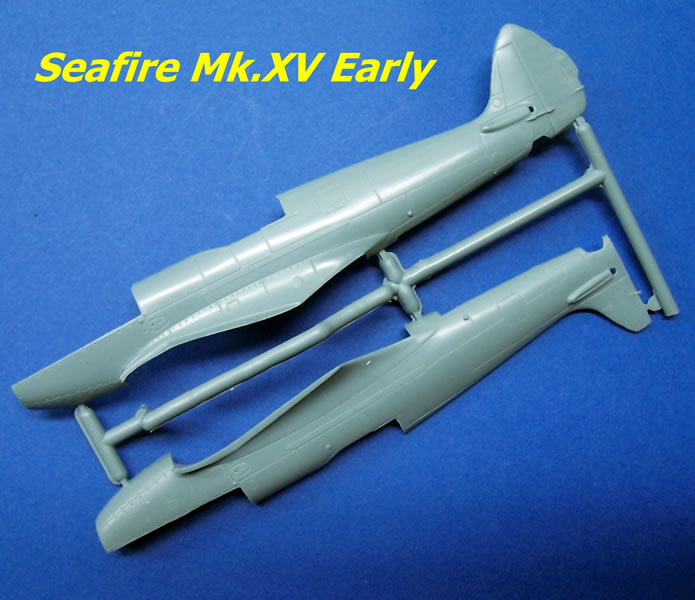
The late Mk.XV & XVII kits feature the sting-hook, and the Mk.XVII has the cut down rear fuselage and teardrop style canopy.
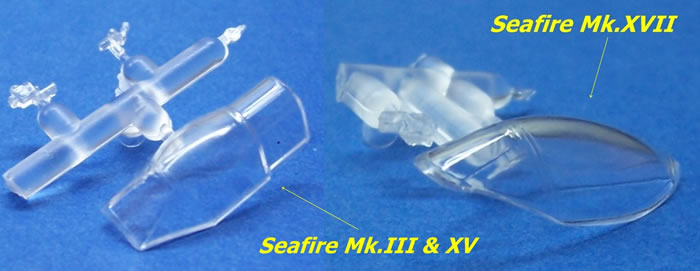
The simple and small main wheel wells have their sides boxed in where the leg retracts by two separate straight parts, whilst curved pieces moulded integrally with the lower wing partially enclose the circular wheel opening, the remaining open portion of which is closed off by a separate flat section part. The crisply moulded undercarriage legs have separate scissors links in the case of the Mk.XV & XVII kits. These plus the doors and wheels all appear fine, as do the two types of tail wheel arrangement.
The cannons and the blanking domes can be a weak point with injected Seafire and Spitfire kits. The Mk.III’s cannons are better than I expected to find in a limited run kit. Cleaned up I think they will be most acceptable. The Mk.XV & XVII kits have very good resin cannons for some reason, and so avoid the potential problem altogether.
The props and spinners look the part for both engine types, with the blades having quite reasonable shape and adequate chord. The exhausts in all cases are resin and have the correct appearance. These fit into a recess created by cementing backing boxes inside then fuselage halves. An under-wing pitot, and where applicable an antenna mast complete the assembly. The only under-wing store on offer is a cigar-style drop tank with the Griffon-engined kits. It would have been nice to have some bombs, rockets and external tanks for all three marks, and possibly the small combat-rated wing-tanks for the Mk.XV & XVII; but I suppose there is no point being greedy.
Colours & Markings
The painting and markings guide for each kit consists of black & white shaded four-view drawings within the instructions, with each scheme supported by a single colour profile on the reverse face of the kit box. Colour call-outs use British military colour names only. The decals, printed by Techmod, look to be good quality with sharp registration. There is sheet of stencils and walkway lines common to each kit but printed within the kit’s own decal sheet. A small four-view guide in the instructions details the stencil locations.
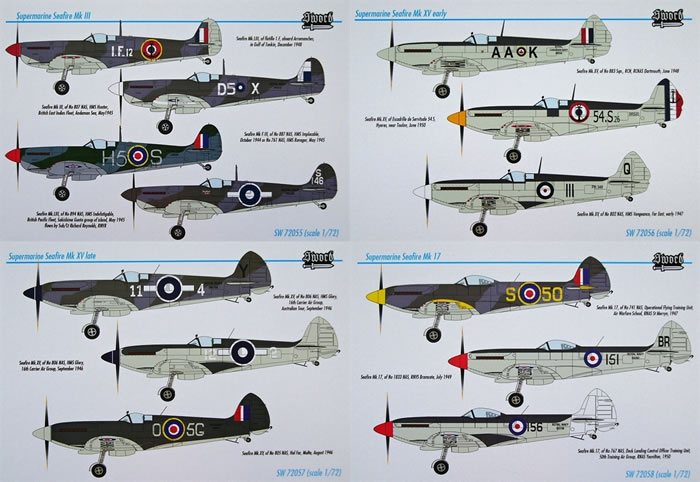
The markings options provided by each kit are as follows:
Seafire Mk.III
-
Flotille I.F, Aeronavale, aboard Aromanches, Gulf of Tonkin, December 1948. (Extra-dark sea grey & slate grey over sky, with a red spinner and sky rudder.)
-
No 807 NAS, HMS Hunter, British East Indies Fleet, Adaman Sea, May 1945. (Extra-dark sea grey & slate grey over sky, with a white spinner and white recognition bands on the wings and tail.)
-
No 887 NAS, HMS Implacable, October 1944 or No761 NAS, HMS Ranger, May 1945. (Dark green & ocean grey over medium sea grey with a red spinner – These are unusual colours for a Seafire I feel, and would advise some reference checking before finishing in these colours.)
-
No 894 NAS, HMS Indefatigable, British Pacific Fleet, Sakishima Gunto Group of Islands, May 1945. (Extra-dark sea grey & slate grey over sky, with a slate grey spinner.)
Seafire Mk.XV Early (A-Frame Hook)
-
No 883 Sqn RCNAS, Dartmouth, June 1948. (Extra-dark sea grey over sky, including the fuselage and fin, with a sky spinner.)
-
Escadrille de Servitude 54.S, Aeronavale, Hyeres, near Toulon, June 1950. (Extra-dark sea grey over sky, including the fuselage and fin, with a yellow spinner.)
-
No 802 NAS, HMS Vengeance, Far East, early 1947. (Extra-dark sea grey over sky, including the fuselage and fin, with a white spinner.)
Seafire Mk.XV Late (Sting Hook)
-
No 806 NAS, HMS Glory, 16th Carrier Air Group, Australian Tour, September 1946. (Extra-dark sea grey over sky, including the fuselage and fin, with a black spinner with thin white line.)
-
No 806 NAS, HMS Glory, 16th Carrier Air Group, Australian Tour, September 1946. (Extra-dark sea grey & slate grey over sky, with a black spinner with thin white line.)
-
No 805 NAS, Hal Far, Malta, August 1946. (Extra-dark sea grey over sky, with a sky spinner.)
Seafire Mk.XVII
-
No 741 NAS, Operational Flying Training Unit, Air Warfare School, RNAS St Merryn, 1947. (Extra-dark sea grey & slate grey over sky, with a yellow spinner, ailerons, wingtips and elevators.)
-
No 1833 NAS, RNVS Bramcote, 1947. (Extra-dark sea grey over sky, including the fuselage and fin, with a red spinner.)
-
No 767 NAS, Deck Landing Control Officer Training Unit, 50th Air Training Group, RNAS Yeovilton, 1950. (Extra-dark sea grey over sky, including the fuselage and fin, with a red spinner and white tailfin, rudder and rear fuselage.)
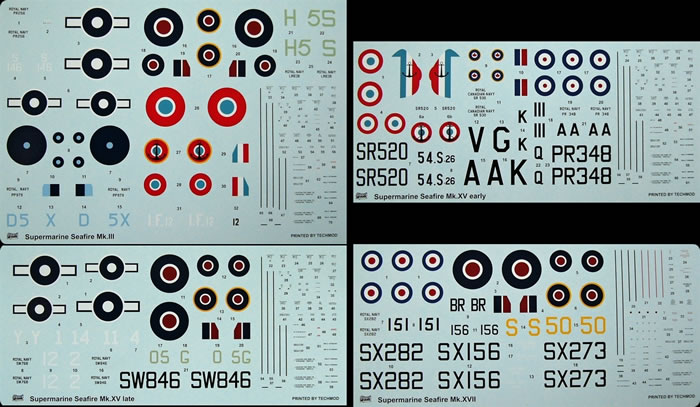
Accuracy & Comparisons
The four Sword Seafire kits look good in terms of general accuracy when compared to in-service images. I have not made a detailed comparison to plans I have because there are no assurances regarding their accuracy. I do however think it useful to compare the review subjects to those kits that have gone before and that remain their rivals.
I compared the review kits to what I consider are the best 1/72 Seafire kits available, these all being CMR kits. Because these are relatively expensive resin kits, I feel that the Ventura Kits, now branded Jays Models, deserve a mention as a cheaper alternative. They too have a reputation for very accurate shape and fine panel lines (I do not own any to make a direct comparison with, but I am familiar with the Ventura-produced product). Yet whilst their retail price is essentially the same as Sword’s, I do not consider them worth comparing in detail because they are so demanding to build. Please rest assured that the Sword kits reviewed here simply blow them away in all respects.
Some will feel that the Octopus (by Pavla) Seafire Mk.III deserves a comparison with its Sword equivalent. I no longer own one to compare directly, and it is now out of production. I do recall that it had an extremely well detailed resin cockpit, but also that it was a “classic limited run kit”, with most of the less favourable connotations that description implies. It had very rough surface finish and overly prominent fuselage reinforcement detail, thick sprue gates, and demanded a lot of cleaning up and fit adjustment. It would take far more effort to build than the Sword kit, and it cost a more originally. Regardless of its accuracy or otherwise, upon which I cannot comment, I am sure that few would buy it preference to the much more refined Sword Seafire Mk.III kit now available.
Ignoring Jays Models and Octopus then, I shall quickly compare the Sword and CMR kits. The flying surfaces are essentially the same in outline for all marks of both brands. A quick (and a little rough & ready) measurement of unassembled parts shows all marks of both brands scale out to be either spot on or within about a millimetre of published dimensions, meaning they are within a scale 3 inches of where they should be. The Sword fuselages for all marks are about 1-mm longer than the CMR equivalents, and this extra length seems to lie in the rear fuselage. CMR’s overall lengths proved closer to the published dimensions. However, overall linear measurements do not give a true picture when proportionality is considered. The comparison seems too close in my opinion to draw any definitive conclusions, other than to say that I think both brands stack up very well for shape and scale, and are almost indistinguishable in this regard.
So taking a snapshot, in my view Sword’s Seafire kits are very good in terms of shape and accuracy because they correspond so well to CMR’s lines. In fact, so much so, that CMR’s folding wing set for their Seafire Mk.XV & XVII kits will work perfectly well with Sword’s equivalent kits. The Sword kits need a bit more assembly effort because they have quite a few more parts compared to the CMR kits, but few will complain about this. Given their price advantage over CMR’s resin Seafires, and the familiarity most modellers have with injected kits, this comparison must weigh heavily in Sword’s favour.
These kits conform almost precisely in outline to CMR’s Seafire kits which I like to use as a benchmark for 1/72 Seafire accuracy, and so I think that they are very good in terms of shape and dimensional accuracy.
The moulding of the kits is very clean and crisp for a limited run product, and rate as some of the best I have seen in this regard. This quality may deteriorate as the moulds wear over time however, so buy early releases to get good examples. Cockpit detail is also very good for an injected kit, requiring only seatbelts to finish for a closed canopy model at least. I cannot think of any points to criticise as such, although a small quibble would be the absence of under-wing stores except for the cigar tank with the Mk.XV & VII kits.
If you have a hangar-deck fetish, you could accessorise your Mk.XV or XVII using CMR Seafire wing fold set, which is a drop-in fit.
These four Seafire kits by Sword are not only the best injected kits of these marks in this scale I have seen, but equal CMR’s in all the ways that matter, with the advantage of injected kit pricing. It should come as no surprise then that I highly recommend them all.
Thanks to Sword Models for this review sample.
Review Text & Blue Background Images Copyright © 2012 by Mark Davies
Page Created 19 June, 2012
Last updated
19 June, 2012
Back to HyperScale Main Page

|
